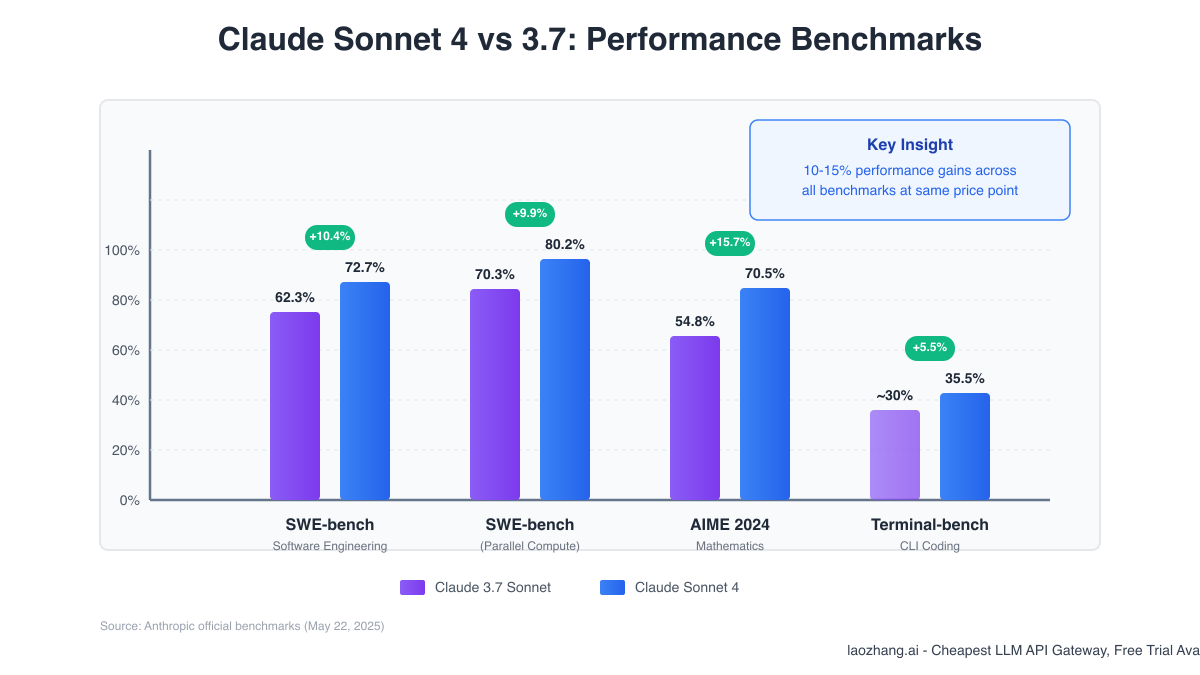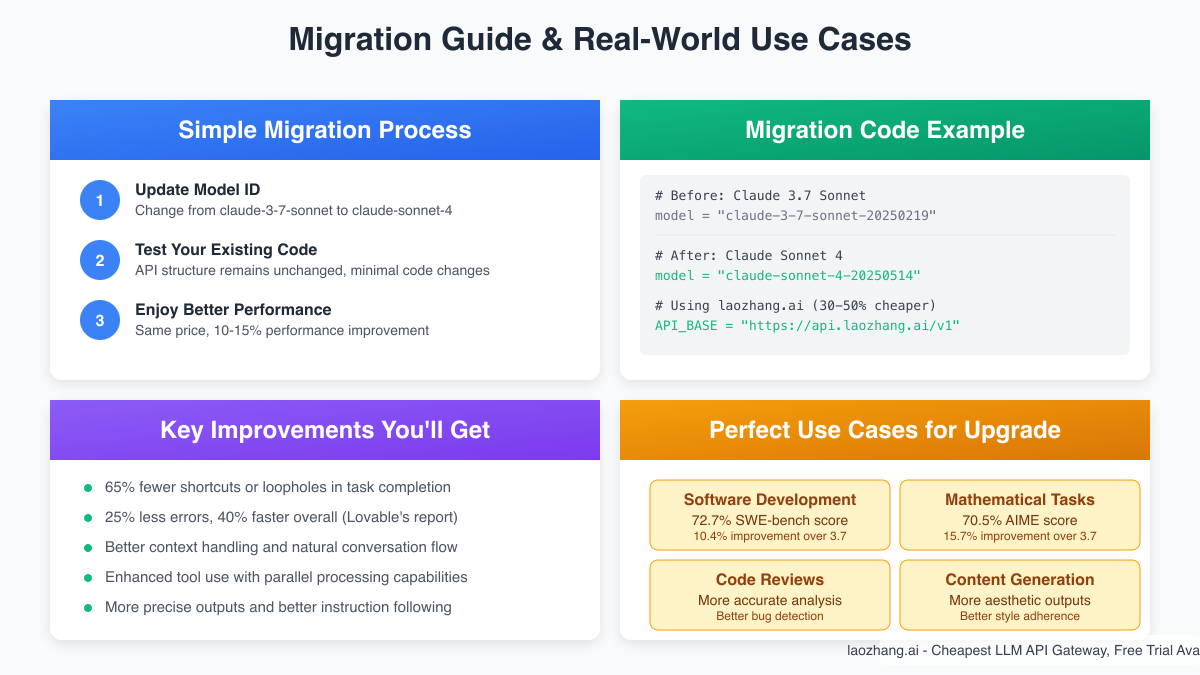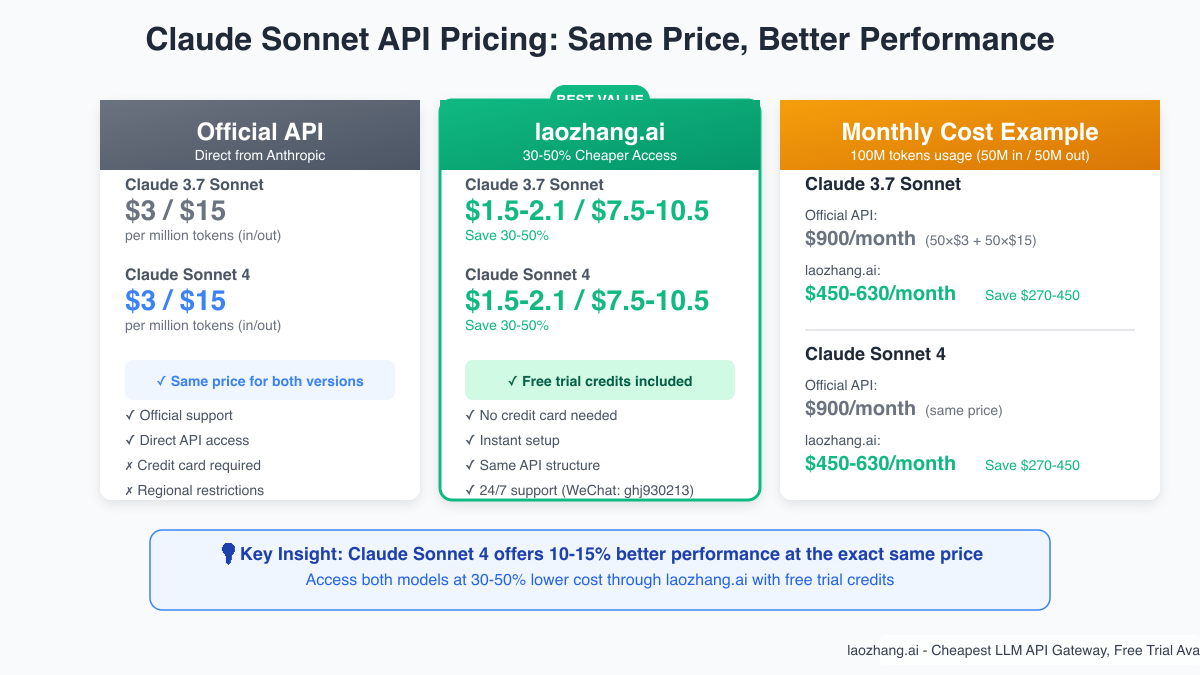When Anthropic released Claude Sonnet 4 on May 22, 2025, developers worldwide faced a crucial question: Is the upgrade from Claude 3.7 Sonnet worth it? The answer, backed by comprehensive benchmarks and real-world testing, is a resounding yes. With a 10.4% performance improvement in software engineering tasks while maintaining the exact same pricing structure, Claude Sonnet 4 represents one of the most compelling upgrades in AI model history.
This isn't just another incremental update. Claude Sonnet 4 delivers substantial improvements across every key metric that matters to developers: from a jump to 72.7% on SWE-bench (compared to 3.7's 62.3%) to a remarkable 15.7% improvement in mathematical reasoning. Most importantly, these gains come at zero additional cost, making the upgrade decision surprisingly straightforward for most use cases.
But the story goes beyond raw performance numbers. Real-world implementations show even more dramatic improvements, with companies like Lovable reporting 25% fewer errors and 40% faster overall performance. GitHub has already integrated Sonnet 4 into Copilot, praising its "soaring" performance in agentic scenarios. For developers and businesses relying on Claude's capabilities, understanding these improvements—and how to leverage them—has become essential.
The Performance Leap: Benchmarks That Tell the Story
The transition from Claude 3.7 Sonnet to Claude Sonnet 4 marks a significant evolution in AI capability, with benchmark improvements that translate directly into real-world productivity gains. Let's examine the data that makes this upgrade so compelling.
SWE-bench: From Good to Great
The SWE-bench (Software Engineering Benchmark) results provide the clearest evidence of Sonnet 4's superiority. Claude 3.7 Sonnet achieved a respectable 62.3% success rate in solving real-world software engineering problems, which increased to 70.3% with parallel compute resources. Claude Sonnet 4 pushes these boundaries further, reaching 72.7% in standard mode and an impressive 80.2% with parallel processing.
This 10.4 percentage point improvement might seem modest on paper, but it represents a fundamental shift in capability. In practical terms, it means Sonnet 4 can successfully resolve complex coding challenges that would have stumped its predecessor. For development teams, this translates to fewer iterations, less debugging time, and more reliable automated code generation.
AIME Mathematics: Breaking New Ground
The American Invitational Mathematics Examination (AIME) results reveal an even more dramatic improvement. Claude 3.7 Sonnet scored 54.8% on these challenging mathematical problems, while Sonnet 4 achieved 70.5%—a remarkable 15.7 percentage point increase. With enhanced compute resources, Sonnet 4 can reach 85.0%, approaching expert human performance levels.
This mathematical prowess isn't just academic. It directly impacts the model's ability to handle algorithm optimization, data analysis, statistical computations, and complex logical reasoning tasks that form the backbone of modern software development.
Terminal-bench: Real-World Coding Impact
Terminal-bench measures a model's ability to perform command-line coding tasks—a crucial skill for real-world development workflows. While Claude 3.7's exact Terminal-bench score wasn't officially published, estimates place it around 30%. Claude Sonnet 4 achieves 35.5% in standard mode and 41.3% with parallel compute, representing a meaningful improvement in practical coding scenarios.

These improvements become even more significant when considered holistically. Anthropic reports that Sonnet 4 demonstrates 65% fewer instances of using shortcuts or loopholes to complete tasks—a critical improvement for production environments where reliability matters more than raw speed.
Feature Improvements That Transform Workflows
Beyond the benchmark numbers, Claude Sonnet 4 introduces qualitative improvements that fundamentally enhance how developers interact with the model. These features address real pain points identified through extensive user feedback from Claude 3.7 deployments.
Enhanced Reasoning and Memory
The most significant architectural improvement in Sonnet 4 is its enhanced reasoning capability. Building on the "thinking mode" pioneered by Claude 3.7 in February 2025, Sonnet 4 refines this approach with more sophisticated contextual understanding. The model now maintains better coherence across long conversations, remembers previous context more reliably, and demonstrates improved logical consistency in its responses.
Real-world testing confirms these improvements. Manus, an AI writing company, praised Sonnet 4's "clear reasoning and aesthetic outputs" when handling complex, nuanced instructions. The model shows particular strength in maintaining context across multiple related queries, making it ideal for iterative development processes where each response builds on previous interactions.
Tool Use and Parallel Processing
Both Claude 3.7 and Sonnet 4 support tool use, but the implementation in Sonnet 4 is markedly superior. The new model can effectively use tools in parallel, dramatically improving efficiency for complex workflows. During extended thinking sessions, Sonnet 4 can alternate between reasoning and tool use—such as web searches or code execution—to gather information and validate its responses.
This parallel processing capability extends beyond tool use. When given access to local files by developers, Sonnet 4 demonstrates significantly improved memory capabilities, effectively creating and maintaining "memory files" to store key information across sessions. This unlocks better long-term task awareness, coherence, and performance in extended projects.
Context Window and Output Quality
While both models share the same 200,000 token context window, Sonnet 4 utilizes this capacity more effectively. The improved attention mechanisms mean that information from earlier in the context remains more accessible and influential in later responses. Developers report that Sonnet 4 maintains relevance and accuracy even when working with extensive codebases or documentation.
Output quality shows marked improvement as well. Code generated by Sonnet 4 tends to be more idiomatic, better structured, and requires fewer modifications before production use. The model demonstrates superior understanding of coding conventions, design patterns, and best practices across multiple programming languages.
Seamless Migration: Your Step-by-Step Guide
One of the most pleasant surprises about upgrading to Claude Sonnet 4 is the simplicity of the migration process. Anthropic has maintained API compatibility, ensuring that existing integrations continue to work with minimal modifications.
API Compatibility
The migration from Claude 3.7 Sonnet to Sonnet 4 is remarkably straightforward. In most cases, you only need to update the model identifier in your API calls:
python# Before: Claude 3.7 Sonnet model = "claude-3-7-sonnet-20250219" # After: Claude Sonnet 4 model = "claude-sonnet-4-20250514"
All other API parameters, including temperature, max_tokens, and system prompts, remain unchanged. Your existing error handling, response parsing, and integration logic will continue to function without modification.
Code Examples: Before and After
Let's examine a practical example of migrating a code review assistant:
python# Claude 3.7 Sonnet Implementation import anthropic client = anthropic.Client(api_key="your-api-key") def review_code_37(code_snippet): response = client.messages.create( model="claude-3-7-sonnet-20250219", messages=[{ "role": "user", "content": f"Please review this code for bugs and improvements:\n\n{code_snippet}" }], max_tokens=2000, temperature=0.3 ) return response.content # Claude Sonnet 4 Implementation (minimal changes) def review_code_4(code_snippet): response = client.messages.create( model="claude-sonnet-4-20250514", # Only change needed messages=[{ "role": "user", "content": f"Please review this code for bugs and improvements:\n\n{code_snippet}" }], max_tokens=2000, temperature=0.3 ) return response.content
The beauty of this migration is that you can run both versions in parallel during your testing phase, allowing for direct comparison of outputs before fully committing to the upgrade.
Common Pitfalls and Solutions
While migration is generally smooth, there are a few considerations to keep in mind:
Response Style Changes: Sonnet 4 may generate slightly different response formats, especially for complex queries. While generally more accurate, you may need to adjust any rigid parsing logic that expects specific formatting.
Performance Characteristics: Although Sonnet 4 is more capable, response times remain similar to Claude 3.7. Don't expect dramatic speed improvements; the gains are in quality, not velocity.
Token Usage: Despite better performance, Sonnet 4 may use slightly different token counts for similar tasks. Monitor your usage during the transition to ensure it aligns with your budget expectations.

Cost Analysis: Same Price, Better Performance
Perhaps the most compelling aspect of the Claude Sonnet 4 upgrade is its pricing structure—or rather, the lack of change in it. Anthropic has maintained identical pricing for both models, making this one of the rare instances in tech where you get significantly more capability for the same cost.
Official Pricing Structure
Both Claude 3.7 Sonnet and Claude Sonnet 4 are priced at:
- Input tokens: $3 per million tokens
- Output tokens: $15 per million tokens
This pricing applies whether you're using the standard model or leveraging extended thinking modes. The consistency means that upgrading to Sonnet 4 provides an immediate ~10-15% performance improvement at zero additional cost—essentially getting more value for every dollar spent.
ROI Calculation for Different Use Cases
Let's examine the return on investment for various scenarios:
Software Development Teams: A team processing 100 million tokens monthly (50M input, 50M output) pays $900/month for either model. With Sonnet 4's 10.4% improvement in SWE-bench performance, they effectively get 10% more successful code completions for the same price—equivalent to $90/month in added value.
Content Generation: Marketing teams using Claude for content creation benefit from Sonnet 4's superior instruction following and more aesthetic outputs. The 25% error reduction reported by real users translates directly to time saved on revisions and editing.
Data Analysis: The 15.7% improvement in mathematical reasoning means more accurate statistical analyses and fewer computational errors, reducing the need for manual verification and correction cycles.
Cost Optimization with laozhang.ai
While the official pricing remains attractive, developers can achieve even greater cost efficiency through laozhang.ai, a leading API gateway service. This platform offers access to both Claude models at 30-50% below official rates, making advanced AI capabilities accessible to a broader range of developers and startups.

With laozhang.ai, the same 100 million token monthly usage that costs $900 through official channels can be reduced to $450-630, representing savings of $270-450 per month. For startups and individual developers, these savings can make the difference between feasible and prohibitive AI integration.
Access Options: Choosing Your Path
Understanding your options for accessing Claude Sonnet 4 is crucial for making an informed decision that balances cost, convenience, and compliance with your organization's requirements.
Direct API Access
The official Anthropic API provides the most straightforward path to Claude Sonnet 4. Benefits include:
- Direct support from Anthropic
- Guaranteed availability and uptime SLAs
- Immediate access to new features and models
- Compliance with enterprise security requirements
However, direct access requires a credit card for billing and may have regional restrictions that affect some developers.
laozhang.ai: 30-50% Savings
For developers seeking cost optimization without sacrificing quality, laozhang.ai presents a compelling alternative. This API gateway service has become increasingly popular, offering:
Significant Cost Reduction: Access both Claude 3.7 and Sonnet 4 at 30-50% below official rates. The platform leverages bulk purchasing to pass savings directly to users.
Simplified Access: No credit card required for initial setup. The platform offers free trial credits upon registration, allowing developers to test both models before committing financially.
Unified API Management: Beyond Claude, laozhang.ai provides access to GPT-4, Gemini, and other leading models through a single API endpoint, simplifying multi-model deployments.
Developer-Friendly Features: Instant setup, usage monitoring dashboards, and responsive support (WeChat: ghj930213) make it particularly attractive for rapid prototyping and development.
Free Trial Options
For developers wanting to test Claude Sonnet 4 before committing, several options exist:
laozhang.ai Free Credits: New users receive free trial credits immediately upon registration at api.laozhang.ai. These credits are sufficient for meaningful testing of both Claude 3.7 and Sonnet 4 capabilities.
Anthropic Claude Free Tier: While limited, Anthropic offers Claude Sonnet 4 access to free users on their web platform, though without API access.
GitHub Copilot Integration: Developers using GitHub Copilot can access Claude Sonnet 4 capabilities through their existing subscription, providing a path to test the model in real development workflows.
Real-World Impact: Developer Success Stories
The true measure of Claude Sonnet 4's improvement lies not in benchmarks but in real-world applications. Early adopters across various industries have reported significant productivity gains and quality improvements.
GitHub Copilot Integration
GitHub's integration of Claude Sonnet 4 into Copilot represents one of the highest-profile adoptions. According to GitHub's announcement, Sonnet 4 "soars in agentic scenarios," particularly excelling at multi-step coding tasks that require understanding complex codebases and maintaining context across multiple files.
Developers using Copilot with Sonnet 4 report more accurate code suggestions, better understanding of project-specific patterns, and fewer nonsensical completions. The model's improved reasoning capabilities shine when dealing with complex refactoring tasks or implementing new features that must integrate with existing code.
Enterprise Adoption Cases
Lovable, a development platform company, provides concrete metrics on Sonnet 4's impact: 25% fewer errors and 40% faster overall development cycles. These improvements came from Sonnet 4's better instruction following and reduced tendency to take shortcuts in problem-solving.
Financial services companies have particularly benefited from the improved mathematical reasoning, using Sonnet 4 for risk analysis, algorithmic trading strategies, and complex financial modeling. The 15.7% improvement in AIME scores translates directly to more accurate quantitative analysis.
Performance Improvements in Production
Production deployments reveal consistent patterns of improvement:
Code Review Automation: Teams report that Sonnet 4 catches more subtle bugs and provides more actionable improvement suggestions. The reduced false positive rate means developers spend less time dismissing irrelevant warnings.
Documentation Generation: Technical writers using Sonnet 4 for documentation report that the model better understands code structure and generates more accurate API documentation with fewer hallucinations.
Customer Support: Companies using Claude for customer support automation find that Sonnet 4 provides more helpful responses and better understands context from previous interactions, leading to higher resolution rates.
Should You Upgrade? A Decision Framework
While the performance improvements and maintained pricing make upgrading seem obvious, different scenarios may warrant different approaches. Here's a framework to guide your decision.
When to Upgrade Immediately
High-Stakes Applications: If accuracy directly impacts your bottom line—financial analysis, medical applications, or critical infrastructure—the 10-15% improvement in accuracy justifies immediate migration.
Active Development: Teams actively developing new features benefit most from Sonnet 4's improvements. The better code generation and reduced error rates compound over time.
Cost-Conscious Operations: Since pricing remains unchanged, any application currently using Claude 3.7 gets immediate value from upgrading. Through services like laozhang.ai, you can even reduce costs while upgrading.
Complex Reasoning Tasks: Applications involving mathematical computation, logical reasoning, or multi-step problem solving see the greatest improvements with Sonnet 4.
When to Wait
Stable Production Systems: If your Claude 3.7 integration is working flawlessly and doesn't require active development, you might delay migration until your next major update cycle.
Highly Customized Prompts: Systems with extensively tuned prompts for Claude 3.7 may need adjustment for Sonnet 4's slightly different response patterns. Plan time for prompt optimization.
Regulatory Compliance: Organizations requiring extensive testing for compliance reasons may need to complete their validation processes before upgrading production systems.
Migration Timeline Recommendations
For most organizations, we recommend a phased approach:
Week 1-2: Test Sonnet 4 in development environments, comparing outputs with Claude 3.7 Week 3-4: Migrate non-critical applications and gather performance metrics Week 5-6: Update production systems with proper monitoring and rollback procedures Week 7-8: Optimize prompts and workflows for Sonnet 4's capabilities
Conclusion: The Future of AI Development
The evolution from Claude 3.7 Sonnet to Claude Sonnet 4 represents more than just a model upgrade—it's a glimpse into the rapid pace of AI advancement. In just three months, Anthropic delivered double-digit performance improvements while maintaining price parity, setting a new standard for the industry.
For developers and businesses, the decision to upgrade is remarkably straightforward. Same price, better performance, minimal migration effort—the equation clearly favors adoption. The 10.4% improvement in software engineering tasks, 15.7% gain in mathematical reasoning, and 65% reduction in shortcut-taking behavior translate directly to better products and more efficient development cycles.
Looking ahead, this upgrade path demonstrates Anthropic's commitment to continuous improvement without price inflation. As AI becomes increasingly central to software development, choosing platforms and providers that deliver consistent value becomes crucial. Whether accessing Claude Sonnet 4 through official channels or cost-optimized services like laozhang.ai (register at api.laozhang.ai for free trial credits), developers now have powerful tools to build the next generation of AI-enabled applications.
The message is clear: if you're still using Claude 3.7 Sonnet, it's time to upgrade. The future of AI development is here, it performs better, and it costs exactly the same. In the fast-moving world of AI, opportunities like this—significant capability improvements at no additional cost—are rare. Don't let this one pass by.
